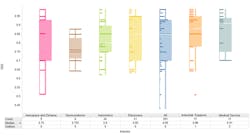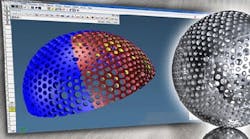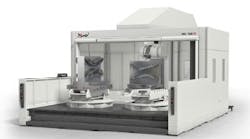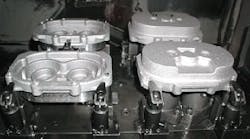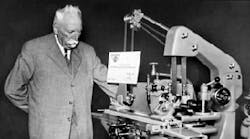Big, heavy and usually involving only one or two parts describes the manual jobs at Parker Machine works.
Onesy-twosy manual jobs at Sterling Machine include machining new throw cranks such as this one measuring 4-in. in diameter and 106-in. long.
Apparatus Repair & Engineering relies on large manual lathes.
There is no way to deny that machines driven by computer numerical controls are the most productive tools available to a shop, but there are many managers and owners who say that manual machines still have a place in shops, and there are some shops that use nothing but manual machines and continue to be profitable.
An editorial on the subject in the January, 2007, issue of American Machinist Magazine (on pg. 6) evoked many responses from readers, especially those who have nothing but manual machines on their shop floors. so we decided to look into the continuing use of manual machines.
We found that the situation does not involve old school versus new school. Instead it hinges on matching the equipment to the job at hand to achieve the best possible results, and just as shops that run all CNC machines have their particular niche parts and job volumes, so do shops that use nothing but manual machine tools.
Parker Machine Works LLC, Sterling Machine, and Apparatus Repair & Engineering inc. are three all-manual shops that service different markets. Each of these shops use manual machine tools for the same reason: Those machines are the most efficient tools to machine the onesy-twosy jobs that keep them in business.
"I'm not anti-CNC, but for what we do, that kind of equipment is just not viable," said Ed Taddeo, owner of Parker Machine Works. The Grand Junction, Colo., shop services the transportation (big trucks), earth-moving vehicle, and oil-field industries. Two guys run the shop that has about 40 manual machines, including lathes, slotters, grinders and boring mills, on its floor to produce industrial parts and to do repair work. In some weeks, the shop puts out two jobs and in others as many as 10 because the parts can be challenging. If a job comes in that requires 20 pieces, Taddeo considers it high volume, and would sub-contract it to another shop.
The shop's jobs typically involve one or two large, heavy parts that can sometimes weigh as much as 6,000 lb. and call for such operations as machining odd keyways or boring to depths of 5 ft.
"We never know what type of part feature we'll have to machine, so that justifies having so many different machines on hand. While my machines are old, they are big, and large parts are my niche market. and for that type of work in my geographic location, I'm the only game in town," Taddeo said. Similarly, Tony Gatto, president of Sterling Machine in Cedar Lake, Indiana, justifies having more machines than machinists to run them in his shop by the fact that every job the shop does is different and requires different machines.
"If you're a manual shop doing one or two-part jobs, you have to have a wide variety of machines because you never know what's going to come through the door," he said, adding that all of his machines are paid for.
The seven-man shop has 15 manual machines and services its customers' product-manufacturing lines by repairing or manufacturing components for such equipment as punch presses, cold header machines and valve bodies. as part size ranges go, the shop tries to accept jobs with parts weighing no more than 10,000 lb, and, 90 percent of the time, it has to work without the aid of blueprints.
Last year, the shop shipped 354 jobs. however, some of those involved multiple components, so Gatto said that number might be closer to 600. he also said that his shop often bids against CNC shops for jobs and typically beats them.
Gatto didn't say exactly how he accomplishes this, but he mentioned that having bigger machines was a key factor. one of the shop's lathes, for example, measures 10-ft between centers.
Jobs for parts that have only oneand two-piece volumes involve challenging parts, and keep the machines at Apparatus Repair & Engineering in Hagerstown, MD., busy. as with Parker Machine Works and Sterling Machine, Apparatus Repair & Engineering keeps a variety of manual machines in its shop area. The company sells, repairs and services electric motors and associated equipment, which includes anything from electronic panels to pumps. in 2006, the 26-employee company's total sales reached $3.5 million.
The shop area, run by Dave Hose, senior mechanic at Apparatus Repair & Engineering, rebuilds and machines electric motor bearing brackets and shafts. The shop has manual engine lathes, some able to swing 38-in. diameters, hose and three others in the shop re-true bearing-bracket surfaces, then press in steel sleeves and turn them to finished size. For damaged shafts, the shop either manufactures new ones, if the motor is important enough to the customer, or repairs them. To repair a shaft, hose and his guys use either spray metalizing or stick welding to build up the damaged surface, then machine the surface to size. Alternately, they may cut off the damaged shaft end, weld a stub shaft in its place and machine that to size.
"Our kind of work does not lend itself to CNC machines because most motor jobs and their damages are completely different from one another," said Denver Weigel, president of Apparatus Repair & Engineering. "Motors made by G.E., reliance and siemens, for example, all vary in external size, so repairing them on CNC machines would involve reprogramming for every individual motor. in the amount of time we would spend programming a CNC machine to cut a shaft, for example, our guys could have it roughed out using a manual machine," he added.
Apparatus Repair & Engineering completes about 400 jobs per month with the manual shop area lending support to the rest of the facility that rebuilds the electrical components of motors. and, according to hose, the chances of working on the same type of motor in terms of size and frame style twice within several months time are slim. The shop area also tests and balances all the rebuilt motors.
Staying competitive
So how do Parker Machine works, Sterling Machine, and Apparatus Repair & Engineering improve their manufacturing processes to stay competitive and win more work when advanced CNC machines and automation aren't an option? For all three shops, tooling is the answer.
While 90 percent of the tooling Parker Machine works uses is off-the-shelf, the shop also incorporates the latest advancements in cutting tools wherever applicable, as does Sterling Machine and Apparatus Repair & Engineering.
"We boost output by constantly incorporating tool technology that improves our processes," said Weigel of Apparatus Repair & Engineering. Last year, his company experienced about a 35 percent increase in sales that he attributes partially to improvements, such as tooling and adding more people, made in the company's manual shop area.




